It is known among big breeders and it’s time that you know it too. Marmosets, Tamarins or Owl monkeys cannot be put together with squirrel monkeys.
Squirrel monkeys are the carrier of the herpes saimiri virus, which is deadly for marmosets, tamarins and owl monkeys. Once they are infected, death can occur within 24 hours. A squirrel monkey who carries herpes saimiri, doesn’t show any symptoms and unfortunately testing for this virus are not conclusive.
A big breeder told me once that he lost a whole colony of marmosets within a few days caused by this virus although his squirrels and marmosets were housed far from each other.
The problem is that you cannot see the virus. It can be spread by handling the food, dishes or toys touched by a squirrel monkey. Just walking from one cage to the other can cause the infection already. (more…)


